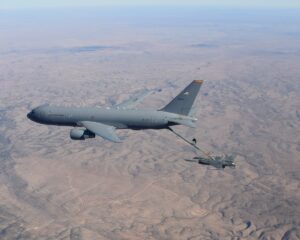The head of Air Mobility Command (AMC) said Monday he has certified the KC-46A tanker is now “worldwide-deployable, combatant command-deployable, combat-deployable” after clearing the aircraft for its final Interim Capability Release (ICR) last Friday.
Air Force Gen. Mike Minihan, the AMC commander, told reporters at the Air & Space Forces Association’s annual conference his focus is now working with Boeing [BA] to address remaining issues on the aircraft, to include getting after the new Remote Vision System (RVS) and fixes with cargo capabilities.

“I’m 100 percent confident in [the KC-46’s] ability for people to fly, fix and support it. I love it. The people that refuel off of it love it. The combatant commands that have been the recipients of the [Employment Concept Exercises] are big fans of it. And you know what, I’m happy that we’ve closed that ICR chapter out,” Minihan said. “There’s lots of more work to do. I’m going to focus on the integration of all the fixes now, because there’s plenty. I’m going to be hypersensitive to the timelines of everything that needs to come back and be addressed and eliminating, as much as I can, the operational impact of those fixes.”
Asked about the decision to clear the KC-46 for operational refueling missions while limitations on the aircraft remain to be addressed, Minihan said holding back the platform while it’s still capable of performing missions would be a “losing approach.”
“The concern would be that we’re saying those limitations are okay, and we’re not. The command’s efforts are going to, as I’ve stated, be focused now on the integration of those fixes so that we can get out of the business of [tactics, techniques and procedures] adjusting for the shortcomings and then really realize the full capability of the jet,” Minihan said. “My job is to win tomorrow. Nobody is going to care about my plans for the KC-46 or my fleet in 10 years if I lose tomorrow. I need it now. I am extremely straightforward with Boeing in my concerns about quality, timelines and costs. But, if I can put an incredibly capable tanker in the fight, then why wouldn’t I.”
Air Force Secretary Frank Kendall was also asked during Monday’s conference whether the service would consider alternatives to the KC-46 if new problems were to arise with the platform.
“We’re going to make KC-46 work,” Kendall told reporters.
Boeing in June said it delivered its 61st KC-46A to the U.S. Air Force, as the company prepared for a program critical design review this year (Defense Daily, June 15).
The end of KC-46A initial operational test and evaluation (IOT&E) and a full-rate production decision are not expected until fiscal year 2024 because of Category I deficiencies with the aircraft’s RVS and the actuator for the refueling boom (Defense Daily, March 31).
Minihan said work on the updated RVS 2.0, which is expected to improve the system’s depth perception, will help address some of the current flight restrictions on the KC-46.
“There are some angles and certain weather phenomena that challenge the RVS. So when we know that’s going to occur we line up the angles differently. That would be an example of what the crews are dealing with. RVS 2.0 will fix that. I’m confident,” Minihan said.
On the KC-46’s cargo-carrying capability, Minihan said the issue will be addressed after the ICR process for the aircraft is fully completed.
“There is an issue with the software on the aircraft and where you place the cargo. There are workarounds, so yes it can carry cargo. We just have to do it more manually than automatically,” Minihan said.
In late August, Boeing was awarded $2.2 billion for delivery of 15 KC-46As under production lot 8 and a $927 million deal to build four of the tankers for Israel by the end of 2026 (Defense Daily, Aug. 31).